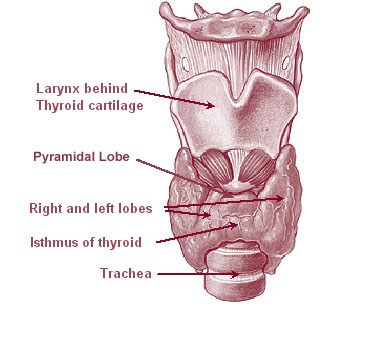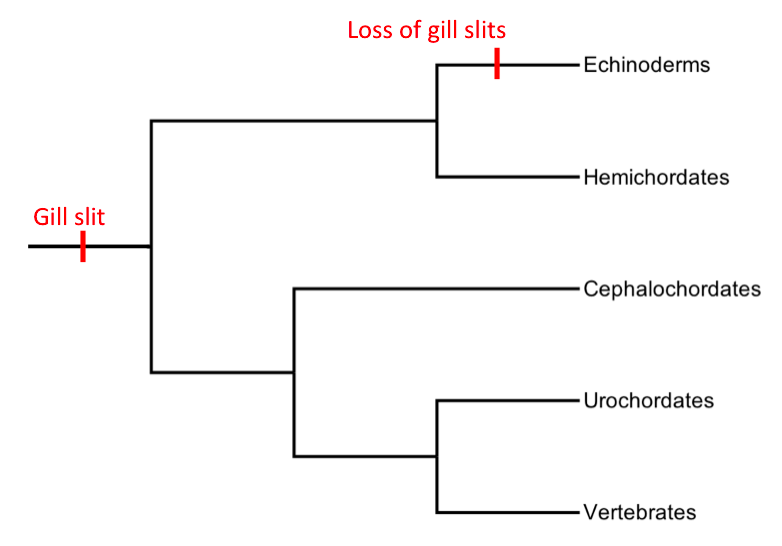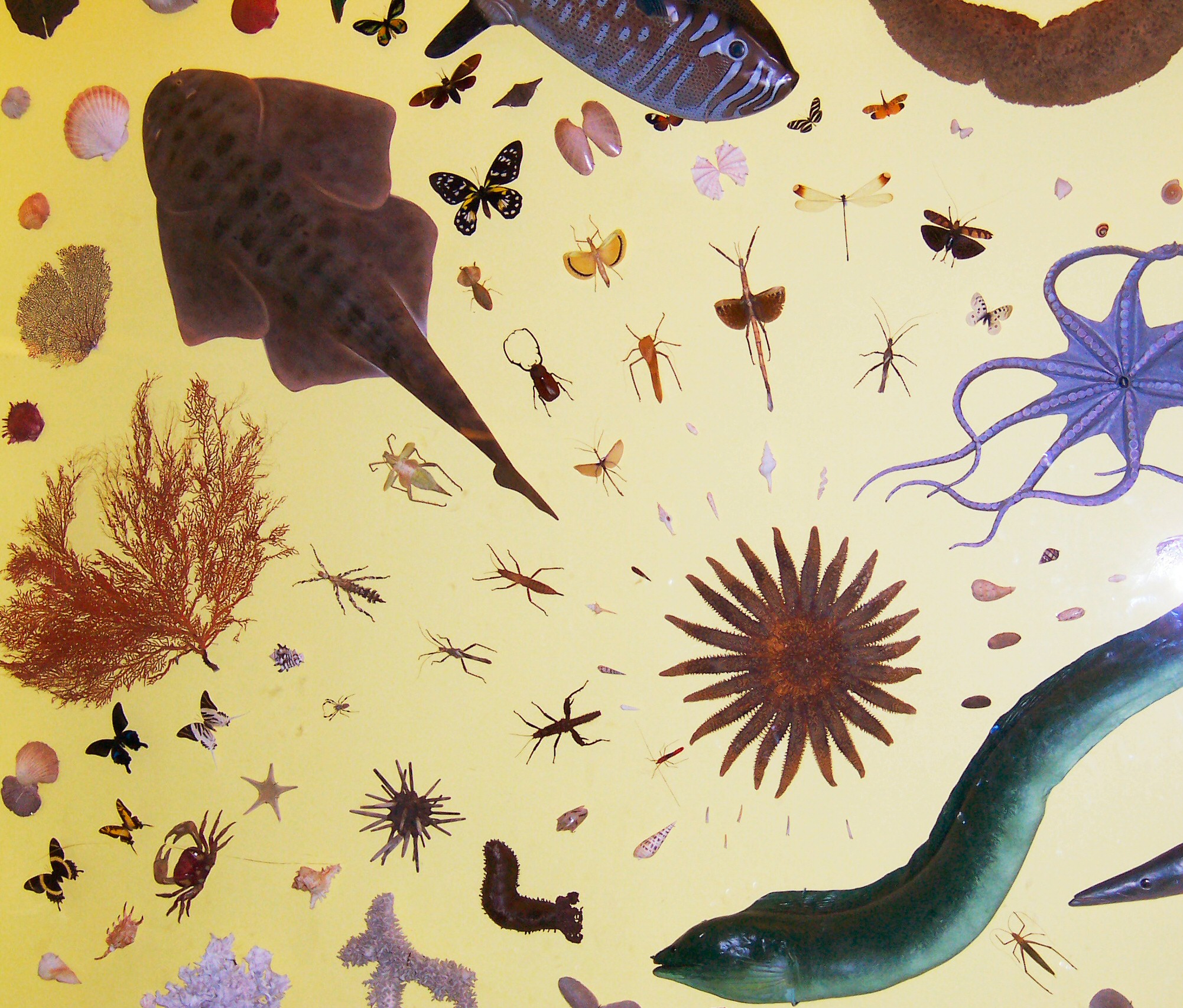|
Chordates
A chordate () is an animal of the phylum Chordata (). All chordates possess, at some point during their larval or adult stages, five synapomorphies, or primary physical characteristics, that distinguish them from all the other taxa. These five synapomorphies include a notochord, dorsal hollow nerve cord, endostyle or thyroid, pharyngeal slits, and a post-anal tail. The name “chordate” comes from the first of these synapomorphies, the notochord, which plays a significant role in chordate structure and movement. Chordates are also bilaterally symmetric, have a coelom, possess a circulatory system, and exhibit metameric segmentation. In addition to the morphological characteristics used to define chordates, analysis of genome sequences has identified two conserved signature indels (CSIs) in their proteins: cyclophilin-like protein and mitochondrial inner membrane protease ATP23, which are exclusively shared by all vertebrates, tunicates and cephalochordates. These CSIs p ... [...More Info...] [...Related Items...] OR: [Wikipedia] [Google] [Baidu] |
Animal
Animals are multicellular, eukaryotic organisms in the Kingdom (biology), biological kingdom Animalia. With few exceptions, animals Heterotroph, consume organic material, Cellular respiration#Aerobic respiration, breathe oxygen, are Motility, able to move, can Sexual reproduction, reproduce sexually, and go through an ontogenetic stage in which their body consists of a hollow sphere of Cell (biology), cells, the blastula, during Embryogenesis, embryonic development. Over 1.5 million Extant taxon, living animal species have been Species description, described—of which around 1 million are Insecta, insects—but it has been estimated there are over 7 million animal species in total. Animals range in length from to . They have Ecology, complex interactions with each other and their environments, forming intricate food webs. The scientific study of animals is known as zoology. Most living animal species are in Bilateria, a clade whose members have a Symmetry in biology#Bilate ... [...More Info...] [...Related Items...] OR: [Wikipedia] [Google] [Baidu] |
Phylum
In biology, a phylum (; plural: phyla) is a level of classification or taxonomic rank below kingdom and above class. Traditionally, in botany the term division has been used instead of phylum, although the International Code of Nomenclature for algae, fungi, and plants accepts the terms as equivalent. Depending on definitions, the animal kingdom Animalia contains about 31 phyla, the plant kingdom Plantae contains about 14 phyla, and the fungus kingdom Fungi contains about 8 phyla. Current research in phylogenetics is uncovering the relationships between phyla, which are contained in larger clades, like Ecdysozoa and Embryophyta. General description The term phylum was coined in 1866 by Ernst Haeckel from the Greek (, "race, stock"), related to (, "tribe, clan"). Haeckel noted that species constantly evolved into new species that seemed to retain few consistent features among themselves and therefore few features that distinguished them as a group ("a self-contain ... [...More Info...] [...Related Items...] OR: [Wikipedia] [Google] [Baidu] |
Zhongxiniscus
''Zhongxiniscus'' is a genus of primitive chordate from eastern Yunnan that lived during the Early Cambrian. Known from a single specimen, it had a small, broad and short, fish-like body that was roughly ten millimeters in length. It possessed S-shaped myomeres, numbering roughly seven per one millimeter of length. Two triangular fins are evident on the dorsal margin. Evolutionary relationships When compared to other Cambrian chordates like the possible cephalochordate '' Cathaymyrus'' and the two known vertebrates '' Haikouichthys'' and '' Myllokunmingia'', ''Zhongxiniscus'' resembles ''Cathaymyrus'' in having S-shaped myomeres, but is different in having a dorsal fin and a shorter body. ''Zhongxiniscus'' approaches in form to '' Haikouichthys'' and '' Myllokunmingia'' in its myomeres and its dorsal fin, but differs from the latter two having zigzag myomeres and fin rays, which ''Zhongxiniscus'' evidently lacks. For these reasons, ''Zhongxiniscus'' is tentatively considered to ... [...More Info...] [...Related Items...] OR: [Wikipedia] [Google] [Baidu] |
Olfactores
Olfactores is a clade within the Chordata that comprises the Tunicata (Urochordata) and the Vertebrata (sometimes referred to as Craniata). Olfactores represent the overwhelming majority of the phylum Chordata, as the Cephalochordata are the only chordates not included in the clade. This clade is defined by a more advanced olfactory system which, in the immediate vertebrate generation, caused the appearance of nostrils. A rudimentary neural crest is present in tunicates, implying its presence in the olfactores ancestor also, as vertebrates have a true neural crest. For this reason, they are also known as Cristozoa. Olfactores hypothesis While the hypothesis that Cephalochordata is a sister taxon to Craniata is of long standing and was once widely accepted—likely influenced by significant tunicate morphological apomorphies from other chordates, with cephalochordates even being nicknamed ‘honorary vertebrates’—studies since 2006 analyzing large sequencing datasets stro ... [...More Info...] [...Related Items...] OR: [Wikipedia] [Google] [Baidu] |
Notochord
In anatomy, the notochord is a flexible rod which is similar in structure to the stiffer cartilage. If a species has a notochord at any stage of its life cycle (along with 4 other features), it is, by definition, a chordate. The notochord consists of inner, vacuolated cells covered by fibrous and elastic sheaths, lies along the anteroposterior axis (''front to back''), is usually closer to the dorsal than the ventral surface of the embryo, and is composed of cells derived from the mesoderm. The most commonly cited functions of the notochord are: as a midline tissue that provides directional signals to surrounding tissue during development, as a skeletal (structural) element, and as a vertebral precursor. In lancelets the notochord persists throughout life as the main structural support of the body. In tunicates the notochord is present only in the larval stage, being completely absent in the adult animal. In these invertebrate chordates, the notochord is not vacuolated ... [...More Info...] [...Related Items...] OR: [Wikipedia] [Google] [Baidu] |
Pikaiidae
''Pikaia gracilens'' is an extinct, primitive chordate animal known from the Middle Cambrian Burgess Shale of British Columbia. Described in 1911 by Charles Doolittle Walcott as an annelid, and in 1979 by Harry B. Whittington and Simon Conway Morris as a chordate, it became the "most famous early chordate fossil," or "famously known as the earliest" chordates. It is estimated to have lived during the latter period of the Cambrian explosion. Since it initial discovery, more than a hundred specimens have been recovered. The body structure resembles that of the lancelet and perhaps it swam much like an eel. A notochord and myomeres (segmented blocks of skeletal muscles) span the entire length of the body, and are considered as the defining signatures of chordate characters. Its primitive feature is indicated by the body covering, a cuticle, which is characteristic of invertebrates and some protochordates. The exact phylogenetic position is unclear. Proposed affinities include ... [...More Info...] [...Related Items...] OR: [Wikipedia] [Google] [Baidu] |
Yunnanozoon
''Yunnanozoon lividum'' (Yunnan + Greek ζῷον ''zôion'', ''lividum''; "livid animal of Yunnan") is an extinct species of possible vertebrate or chordate from the Lower Cambrian, Chengjiang biota of Yunnan province, China. It is thought of as a deuterostome suspected of being either a hemichordate or chordate. In 2022, a study reanalyzed fossils of ''Yunnanozoon'' and found it to be one of the earliest members of the vertebrate family tree. ''Yunnanozoon'' is similar to the form '' Haikouella'', which is almost certainly a chordate. Still, there are anatomical differences from ''Haikouella'', including a smaller stomach and much larger (1 mm) pharyngeal teeth. It is by no means certain whether Yunannozoon possessed features such as a heart, gills, etc., which are seen in well-preserved specimens of '' Haikouella''. ''Yunnanozoon'' somewhat resembles the Middle Cambrian '' Pikaia'' from the Burgess shale of British Columbia in Canada. Thirteen pairs of symmetri ... [...More Info...] [...Related Items...] OR: [Wikipedia] [Google] [Baidu] |
Thyroid
The thyroid, or thyroid gland, is an endocrine gland in vertebrates. In humans it is in the neck and consists of two connected lobes. The lower two thirds of the lobes are connected by a thin band of tissue called the thyroid isthmus. The thyroid is located at the front of the neck, below the Adam's apple. Microscopically, the functional unit of the thyroid gland is the spherical thyroid follicle, lined with follicular cells (thyrocytes), and occasional parafollicular cells that surround a lumen containing colloid. The thyroid gland secretes three hormones: the two thyroid hormones triiodothyronine (T3) and thyroxine (T4)and a peptide hormone, calcitonin. The thyroid hormones influence the metabolic rate and protein synthesis, and in children, growth and development. Calcitonin plays a role in calcium homeostasis. Secretion of the two thyroid hormones is regulated by thyroid-stimulating hormone (TSH), which is secreted from the anterior pituitary gland. TSH is reg ... [...More Info...] [...Related Items...] OR: [Wikipedia] [Google] [Baidu] |
Pharyngeal Slit
Pharyngeal slits are filter-feeding organs found among deuterostomes. Pharyngeal slits are repeated openings that appear along the pharynx caudal to the mouth. With this position, they allow for the movement of water in the mouth and out the pharyngeal slits. It is postulated that this is how pharyngeal slits first assisted in filter-feeding, and later, with the addition of gills along their walls, aided in respiration of aquatic chordates. These repeated segments are controlled by similar developmental mechanisms. Some hemichordate species can have as many as 200 gill slits. Pharyngeal clefts resembling gill slits are transiently present during the embryonic stages of tetrapod development. The presence of pharyngeal arches and clefts in the neck of the developing human embryo famously led Ernst Haeckel to postulate that " ontogeny recapitulates phylogeny"; this hypothesis, while false, contains elements of truth, as explored by Stephen Jay Gould in ''Ontogeny and Phylogeny''.. ... [...More Info...] [...Related Items...] OR: [Wikipedia] [Google] [Baidu] |
Dorsal Nerve Cord
The dorsal nerve cord is a unique feature to chordates, and it is mainly found in the Vertebrata chordate subphylum. The dorsal nerve cord is only one embryonic feature unique to all chordates, among the other four chordate features-- a notochord, a post-anal tail, an endostyle, and pharyngeal slits. The dorsal hollow nerve cord is a hollow cord dorsal to the notochord. It is formed from a part of the ectoderm that rolls, forming the hollow tube. This is important, as it distinguishes chordates from other animal phyla, such as Annelids and Arthropods, which have solid, ventral tubes. The process by which this is performed is called invagination. The cells essentially convolute into the body cavity, arranging themselves on the dorsal plane above the notochord, as mentioned above. The evolutionary explanation to this adaptation from a solid cord to hollow tube is unknown. In vertebrates, the dorsal nerve cord is modified into the central nervous system, which comprises the brain an ... [...More Info...] [...Related Items...] OR: [Wikipedia] [Google] [Baidu] |
Bilateral Symmetry
Symmetry in biology refers to the symmetry observed in organisms, including plants, animals, fungi A fungus (plural, : fungi or funguses) is any member of the group of Eukaryote, eukaryotic organisms that includes microorganisms such as yeasts and Mold (fungus), molds, as well as the more familiar mushrooms. These organisms are classified ..., and bacteria. External symmetry can be easily seen by just looking at an organism. For example, take the face of a human being which has a plane of symmetry down its centre, or a pine cone with a clear symmetrical spiral pattern. Internal features can also show symmetry, for example the tubes in the human body (responsible for transporting gases, nutrients, and waste products) which are cylindrical and have several planes of symmetry. Biological symmetry can be thought of as a balanced distribution of duplicate body parts or shapes within the body of an organism. Importantly, unlike in mathematics, symmetry in biology is always ... [...More Info...] [...Related Items...] OR: [Wikipedia] [Google] [Baidu] |





